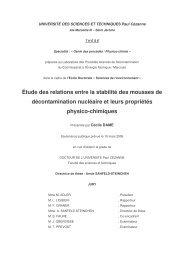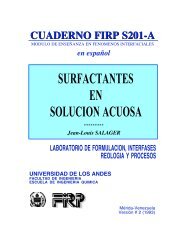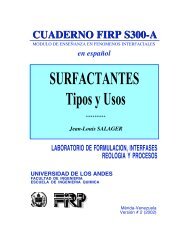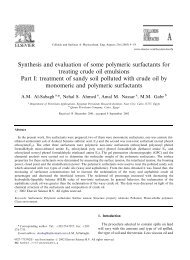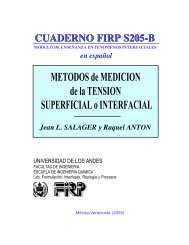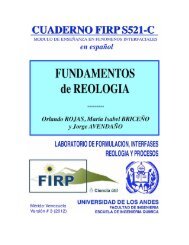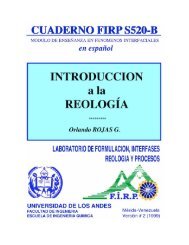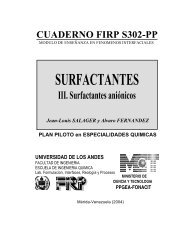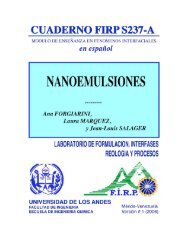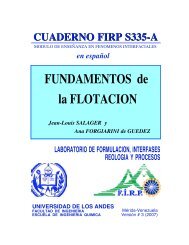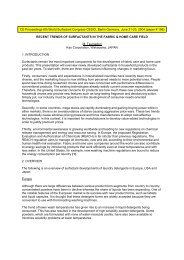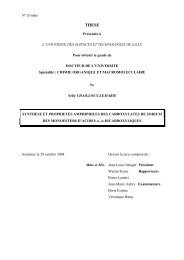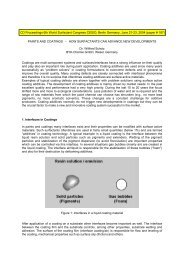Solubilization-emulsification mechanisms of detergency
Solubilization-emulsification mechanisms of detergency
Solubilization-emulsification mechanisms of detergency
You also want an ePaper? Increase the reach of your titles
YUMPU automatically turns print PDFs into web optimized ePapers that Google loves.
C.A. Miller and K.H. Raney/Colloids Surfaces A: Physicochem. Eng. Aspects 74 (1993) 169-215 183<br />
Fig. 15. PIT values for non-ionic surfactant-water-nhexadecane-oleyl<br />
alcohol systems [12]. Reprinted<br />
with permission <strong>of</strong> the American Oil Chemists'<br />
Society.<br />
below its cloud point, one might expect that<br />
phase behavior in the dilute region would be<br />
similar to that described in the preceding<br />
section, i.e. the L 1-L 2 region would terminate in<br />
a three-phase region involving either the D' or<br />
the La phase. Experiments at 30ºC with C 12E 7<br />
and oils having ratios <strong>of</strong> n-hexadecane to oleyl<br />
alcohol <strong>of</strong> 3/1 and 1/1, respectively, showed that<br />
such behavior did, in fact, occur, with the third<br />
phase being the lamellar liquid crystal Lα [60].<br />
However, in contrast to the situations shown in<br />
Fig. 8 and 14 where the oil phase solubilizes<br />
modest amounts <strong>of</strong> water, L 2 phases in these<br />
systems extended to compositions containing up<br />
to 75-80% water which were in equilibrium with<br />
aqueous micellar solutions. Evidently, the<br />
presence <strong>of</strong> hydrocarbon and <strong>of</strong> the double bond<br />
in the alcohol chain makes the surfactant films<br />
sufficiently flexible so that the L 2 phase can<br />
invert continuously and become water<br />
continuous, ultimately reaching compositions<br />
comparable to those <strong>of</strong> the D' phase in systems<br />
such as that shown in Fig. 8. The relevance <strong>of</strong><br />
this behavior to <strong>detergency</strong> is discussed later.<br />
When the long-chain alcohol is mixed with a<br />
liquid triglyceride instead <strong>of</strong> with a<br />
hydrocarbon, multiphase regions containing the<br />
D' phase are prominent, as is shown in Fig. 16<br />
[61] for the C 12E 6-water-triolein-oleyl alcohol<br />
system. The sequence <strong>of</strong> phases observed with<br />
increasing temperature in Fig. 16 for oils having<br />
oleyl alcohol contents exceeding about 20% is<br />
the same as was found for the water-non-ionic<br />
surfactant-triolein systems discussed in section<br />
3.3, as may be seen, for instance, along the<br />
right-hand boundary <strong>of</strong> Fig. 12 for water-C 12E 4-<br />
Fig. 16. Partial phase diagram <strong>of</strong> C12E6-water-triolein-oleyl alcohol system with 10 wt.% surfactant, 45 wt.%<br />
water, and 45 wt.% mixed oil [61]. The symbol IV denotes the four-phase region W + D'+ D + O.



